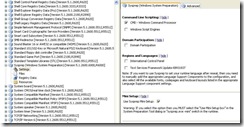Sysprep Now in Windows Embedded Standard
In the latest Embedded Windows product, namely Windows Embedded Standard (download the Customer Technology Preview) a number of new features make their debut. One of the new features included in this release is the Windows System Preparation Tool (Sysprep).
Sysprep is a tool that normally ships as part of an OEM Preinstallation Kit (OPK). It is a technology that you can use with other deployment tools to install Microsoft Windows operating systems with minimal intervention by an administrator or technician. Sysprep is typically used during large-scale rollouts when it would be too slow and costly to have administrators or technicians interactively install the operating system on individual computers. This process of creating a master image that can then be customized and deployed to multiple machines is also referred to as cloning.
In XP Embedded we offered an Embedded version of cloning technology through the System Cloning Tool. This allows developers to specify when they want to "seal" the image to create the master image (either at the end of setup or later, after some sort of customization of the image), and also has the option to configure some settings offline (before the image has been deployed and run through setup) which may reduce the amount of customization that needs to be done after the image has booted up. Sysprep also has the capability of configuring settings, albeit only on a running image and does not have the ability to retain some of the settings that were configured before sysprep ran.
Sysprep in Windows Embedded Standard is not a replacement for the System Cloning Tool, but is included for the primary purpose of enabling another great new feature- the SCCM Operating System Deployment (OSD) functionality that allows Embedded images to be deployed to target machine in an enterprise using SCCM. The "mini" mode of sysprep is used in this scenario to apply certain settings to the target machines after they have been deployed (such as joining a domain, setting an administrator password etc.).
When the "mini" mode of sysprep is selected in the sysprep dialog box, or the -mini switch is specified in the command line, sysprep can consume an inf file (sysprep.inf) that specifies what settings should be applied to the sealed image after it has been deployed to multiple machines. This process can be fully automated by running sysprep using the -quiet switch, so no user interaction is required after the sealed image has been deployed. If sysprep.inf is not present in the same folder as sysprep.exe then the user will be presented with a variety of dialogs to walk through configuring settings such as computer name, PID, timezone and region, administrator name and password. The following is a list of the minimal sections that need to be in the sysprep.inf in order to fully automate the mini setup process:
[GuiUnattended]
Set OemSkipRegional equal to 1.[UserData]
FullName
OrgName[UserData]
ComputerName
ProductID[GuiUnattended]
AdminPassword[GuiUnattended]
TimeZone[Networking]
[Identification]
JoinWorkgroup (join a workgroup)
Additional settings that are may be useful for Embedded images include:
[Unattended]
OemSkipEula[GuiUnattended]
Autologon
AutoLogonCount
OEMSkipWelcome
Of course, there is much more to Sysprep than detailed in this blog article, some applicable to the Embedded space and some not. Look out for a more detailed blog or white paper on this topic in the future.
ConfigUI of the Sysprep component in Target Designer
- Lynda
Technorati Tags: XPe, Embedded
Comments
Anonymous
July 07, 2008
PingBack from http://blog.a-foton.ru/2008/07/sysprep-now-in-windows-embedded-standard/Anonymous
July 08, 2008
We are looking for a way to deploy WePOS. We have SMS 2003 and were hoping that the OS deployment feature pack could do it. Will this work? Or what other direction should we be looking?Anonymous
July 08, 2008
The comment has been removedAnonymous
July 09, 2008
Thanks for the response Terry. The links are helpful but I can't fine the answer the question of whether the WePOS 1.1 cloned images can be deployed with SMS 2003 OS Deployment feature pack. The next version of SMS, System Center Configuration Manager 2007, documentation specifically says that it supports the deployment of WePOS images, but the 2003 docs do not mention it.Anonymous
July 09, 2008
Lin, The Windows Embedded for Point of Service blog may be of more help to you than the Windows Embedded blog. http://blogs.msdn.com/pointofservice/default.aspx I cannot speak for the SMS product, but essentially if you can deploy a cloned image through SMS 2003 then I don't see any reason why you would not be able to deploy a cloned image of WEPOS. I would suggest that you verify the capability with SMS. You might try Steve Rachui's blog: http://blogs.msdn.com/steverac/ Best of luck. -Terry
